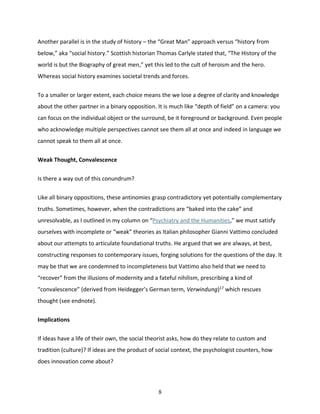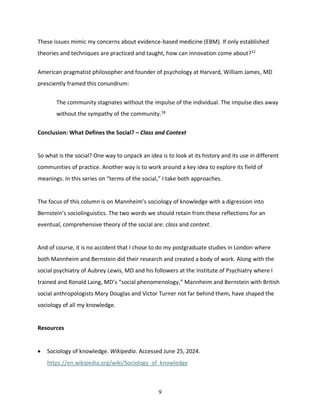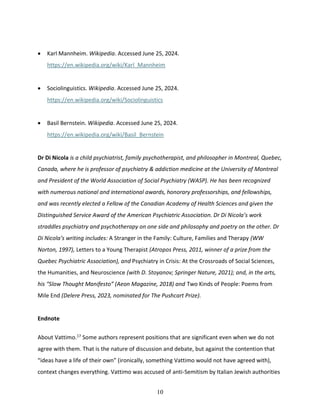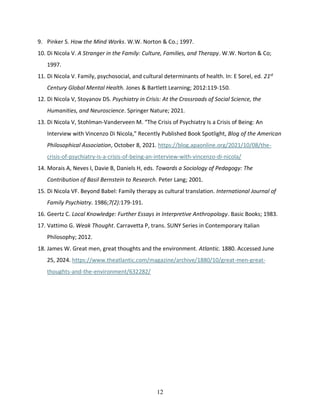Terms of the Social II: The Sociology of Knowledge
- 1. 1 Psychiatric Times Home page teaser: Ideas are a product of their context. Series|Second Thoughts Link: https://www.psychiatrictimes.com/view/terms-of-the-social-ii-the-sociology-of- knowledge Terms of the Social II: The Sociology of Knowledge June 28, 2024 Vincenzo Di Nicola, MPhil, MD, PhD, FCAHS, DLFAPA, DFCPA The principal thesis of the sociology of knowledge is that there are modes of thought which cannot be adequately understood as long as the social origins are obscured. – Karl Mannheim1 The value of creating and updating a lexicon for social psychiatry is not only an academic exercise but a task that necessarily follows from the fundamental shift that social psychiatry signaled through its three main branches (see my column, “Social Psychiatry Comes of Age”):2 • Epidemiological studies (SDH, ACE), where the shift is away from the individual and the clinic, and populations became the focus of research. • Community psychiatry, where the shift is away from the individual in the institution, and the community became the locus of intervention. • Relational therapies (couple, family, and group therapies), where the shift is from the individual to relationships, and relations became the praxis, the object of study and intervention.
- 2. 2 Put simply, the value of such a lexicon lies in its capacity to grasps the problems that arise in psychiatry considered from a social perspective. And that applies both on the level of social observations about the world and clinical practice re-imagined through social context. Such an enlarged vocabulary for all that is “social” in psychiatry, psychology and psychotherapy should give us a way of thinking and talking about such challenges. I offered just such an illustration in my last column on children and the COVID-19 syndemic. Another reason to elaborate a lexicon of social psychiatry is that to make sense of our key words, we need a theory that binds them together into a coherent vision. Do we have such a lexicon and such a theory? In my social psychiatry manifesto published in the inaugural issue of World Social Psychiatry in 2019,2 I argued that we do not: “Social psychiatry has harnessed powerful methodologies from epidemiology and adopted some compelling community and social principles (often in reaction or resistance to institutional psychiatry), yet a comprehensive, compelling, and consensual theory eludes the field. The best we have are statements of social psychiatry's principles and values, thoughtfully expressed.” And while the definitions of social psychiatry that I reviewed by leading social psychiatrists in WASP’s 60 year history – American-Canadian Alexander Leighton, MD's epidemiological model, Greek George Vassiliou, MD and Romanian-American Eliot Sorel, MD’s “science of Anthropos,” and Swiss Luc Ciompi, MD’ s “philosophical pluralism” wedded to community psychiatry – bring us closer to a mission statement, none of them explicitly formulates a theory of social psychiatry.2 Such a theory requires a deep dive into the roots of all that is social – “the terms of the social” – that is at the heart of social psychiatry.
- 3. 3 What Is at the Heart of the Social? Social psychiatry is concerned with the relationships between mental disorder and sociocultural processes. – Alexander Leighton, MD3 American-Canadian psychiatric epidemiologist Alexander Leighton, MD defined it as n > 1, but beyond the group, there is also context – human beings live with each other in a time and a place. The immediate implication for us in the psy disciplines is this: mental, relational and social suffering have a collective history and a shared geography. Some people claim, nonetheless, that their preoccupations, their reflections are beyond time and place, to enter another sphere, another level of activity such as philosophy or scientific research, to reach for transcendent truths. These are at best, laudable exceptions. Does this also apply to cognition, emotion, behavior, or family and social relationships? Let us take a closer look. The Sociology of Knowledge: “Ideas Are a Product of Their Context” McGill University, Montreal, mid-1970s. I was in the Honors Program in Psychology, a select group of undergraduates who met for the Honors Seminar once a week to discuss our research projects and debate emerging trends in the field. After the seminar, we would go to Pam- Pam’s, a Hungarian café where we continued our discussions. I dubbed our group the “Saint Joan Society” after seeing George Bernard Shaw’s play about the French heroine who was guided by the voice of God because the play staged many of our debates about mind and nature, individual versus society, madness against faith.4 In my reading, whether Joan of Arc was understood as a psychotic or a saint depended on the context. As my professor of Abnormal Psychology, Bob Pihl put it, “What’s normal depends not so much on what you do but where and with whom you do it.” Pihl was Canadian psychologist Jordan Peterson’s doctoral advisor at McGill (see my column, “The Trouble with Normal”).
- 4. 4 One afternoon, I invited my friend Judy, a sociology student who had introduced me to the work of Hungarian Jewish sociologist Karl Mannheim on the sociology of knowledge. As it happens, Mannheim whose career brought him to the London School of Economics, founded by George Bernard Shaw and the Fabian Society, was also involved in a discussion group in London called “The Moot” that included Anglo-American poet T.S. Eliot on the role of religion and culture in society. The core of Mannheim’s theory on the sociology of knowledge concerns the relationship between culture, including knowledge, and what he called “social reality.” The case studies of ideology and utopia, which gave his most famous book its title, proposed that everyone’s beliefs were a product of the context in which they were created: The sociology of knowledge seeks to comprehend thought in the historical-social situation out of which individually differentiated thought only very gradually emerges.1 Mannheim’s ideas were met with both curiosity and criticism by our group, so we staged a debate between Steve Pinker and myself, with my friend Judy as an invited guest, at our honors seminar. Judy and I presented an overview of Mannheim’s work with the message that “ideas are a product of their context” and what it meant for psychology. Our examples ranged from the psychology that emerged from the collectivist Soviet Union with such thinkers as Lev Vygotsky on the social origin of mind and neuropsychologist Alexander Luria who together founded cultural-historical psychology to the behavioral psychology of B.F. Skinner and Freudian psychoanalysis of the more individualistic USA. And we brought this point home with a study that was very topical in developmental psychology, Urie Bronfenbrenner’s Two Worlds of Childhood5 – a book we had all read – that compared growing up in the US and the USSR. Bronfenbrenner claimed that, “interpersonal relationships, even [at] the smallest level of the parent-child relationship, did not exist in a social vacuum but were embedded in the larger social structures of community, society, economics and politics.” Sui Generis: “Ideas Have a Life of Their Own”
- 5. 5 Steve countered that “ideas have a life of their own,” and turned our examples on their head by pointing out that behavioral psychology had roots in radically different societies – physiologist Ivan Pavlov’s classical conditioning experiments in Russia (later the Soviet Union), and psychologists John B. Watson’s behaviorism and B.F. Skinner’s operant conditioning in the USA. That argument convinced our professor, Ronald Melzack, who noted that his famous “gate control theory of pain” reflected work he had done in societies as far-flung as Montreal, London, England, Pisa, Italy, and Cambridge, MA.7 In fact, it was Steve who had introduced our group to Luria’s The Mind of a Mnemonist6 and gave us cultural context about Bronfenbrenner who was a Russian Jew, born in Moscow and raised in the USA, where he was a co-founder of the pioneering “Head Start” program for disadvantaged children. Paradoxically true to his Soviet roots, Bronfenbrenner contributed a socialist approach to child poverty and cognitive development in the capital of capitalism. Was Head Start an example of an idea that has a life of its own, transcending ideological divides for the sake of children, or was Bronfenbrenner richly responsive to the particular social context of child poverty in the USA, having been sensitized to social context by his childhood in Moscow and his altruistic father who worked with the developmentally disabled? Steve Pinker went on to have a distinguished career in cognitive psychology at Harvard, focused on The Language Instinct8 and How the Mind Works.9 The sui generis versus contextual view of ideas was reflected too in the language debates of the time. In his controversial study of Verbal Behavior, Harvard’s B.F. Skinner held that language is learned through social reinforcement whereas linguist Noam Chomsky at MIT argued a behavioral approach could not account for new verbal constructions, only repetitions, and that language is in fact a kind of human instinct, as Steve Pinker later brilliantly elaborated in his book of that name.8 On the other hand, I have dedicated my career to the contextual questions that arose from that seminar about the sociology of knowledge – from social and cultural psychiatry, to my model of cultural family therapy,10 to family, psychosocial, and cultural determinants of health,11 and social psychiatry and social philosophy.12,13
- 6. 6 Sociolinguistics: Language Codes In terms of language, for example, having growing up bilingual and studied several other languages before my undergraduate studies in psychology, I was much more interested in the cultures that each language reflected and in the new field of sociolinguistics that called language a code. British sociolinguist Basil Bernstein’s14 theory of restricted (extraverbal) and elaborated (verbal) codes spoke directly to my experience of “code-switching” from one language community to another, including varieties of Italian, English and French in different social contexts.10,15 Interesting to note that Bernstein became the Karl Mannheim Chair of the Sociology of Education at London’s Institute of Education, which was literally just around the corner from my college in London and where I sat in on Bernstein’s lectures. His own experience of growing up in a Jewish immigrant family in London’s East End where the lower class argot jarred with the posh accents of the University of London shaped his views of language, class and society. In my case, my mother tongue was not Italian but a local dialect of the Abruzzo, so that I had to learn national Italian as a fourth language after English and French. And, like Bernstein, what has always impressed me is the “local knowledge,” to use anthropologist Clifford Geertz’s16 simple but rich concept, that each language community represents, not to mention the social class differences that are always present. Antinomies of Reason The sui generis versus the contextual approach to intellectual history reflects a deep strain of Western thought that German philosopher Immanuel Kant characterized as antinomies in his Critique of Pure Reason (1781), a foundational text of the Enlightenment. Antinomies are paradoxes that emerge from our understanding of the world which can be cast as thesis (argument or theory) and antithesis (a counter-argument), following Kant. Some famous antinomies in the history of thought include British philosopher Isaiah Berlin’s “the hedgehog and the fox” in which he argued that some thinkers are like wide-ranging
- 7. 7 divergent foxes (Shakespeare, Montaigne) while others are deeply-burrowing single-minded hedgehogs (Dante, Dostoyevsky). Closer to home, Carl Jung, MD called his version of psychoanalysis “depth psychology,” burrowing deeply into the “collective unconscious,” while relational therapies range more broadly across family and social relationships (see my column on family therapy [https://www.psychiatrictimes.com/view/-the-web-of-meaning-family-therapy-is-social- psychiatrys-therapeutic-branch]). In fact, we can generate almost endless examples of this antinomy between individual and collective notions: “person-centered psychiatry” versus social psychiatry or “single-case studies” versus group comparisons. Other Domains – Philosophy, Literature, History In highly personal memoirs and reflections that were so unique that they created a new form, the essay, French philosopher Michel de Montaigne (1533-1592) scaled what he called “the spiral staircase of the self.” If I had to choose the antinomic partner to Mannheim’s sociology of knowledge, it would be Montagne’s essays. “I am myself the matter of my book,” he confessed and turned himself into his own experimental subject. Similar to the notion that “ideas have a life of their own,” the New Criticism concentrated literary criticism on the text, arguing that a poem is “self-referential” with the “theory of impersonality” and what Anglo-American poet T.S. Eliot called the “objective correlative.” The “intentional fallacy” argued against the relevance of the writer’s intentions while the “affective fallacy” set aside the reader's emotional reaction to a literary work as a valid means of analyzing a text. We can summarize this approach with the slogan: “the text itself” – not the writers’ biography, nor their intentions, nor the cultural history of words, themes, and literary traditions, nor the reader’s response. In other words, New Criticism takes the text out of social context. The alternative is to attend to the history and meaning of words and the community in which they arise. Sound familiar? That is what we try to do in relational therapy and social psychiatry.
- 8. 8 Another parallel is in the study of history – the “Great Man” approach versus “history from below,” aka “social history.” Scottish historian Thomas Carlyle stated that, “The History of the world is but the Biography of great men,” yet this led to the cult of heroism and the hero. Whereas social history examines societal trends and forces. To a smaller or larger extent, each choice means the we lose a degree of clarity and knowledge about the other partner in a binary opposition. It is much like “depth of field” on a camera: you can focus on the individual object or the surround, be it foreground or background. Even people who acknowledge multiple perspectives cannot see them all at once and indeed in language we cannot speak to them all at once. Weak Thought, Convalescence Is there a way out of this conundrum? Like all binary oppositions, these antinomies grasp contradictory yet potentially complementary truths. Sometimes, however, when the contradictions are “baked into the cake” and unresolvable, as I outlined in my column on “Psychiatry and the Humanities,” we must satisfy ourselves with incomplete or “weak” theories as Italian philosopher Gianni Vattimo concluded about our attempts to articulate foundational truths. He argued that we are always, at best, constructing responses to contemporary issues, forging solutions for the questions of the day. It may be that we are condemned to incompleteness but Vattimo also held that we need to “recover” from the illusions of modernity and a fateful nihilism, prescribing a kind of “convalescence” (derived from Heidegger’s German term, Verwindung)17 which rescues thought (see endnote). Implications If ideas have a life of their own, the social theorist asks, how do they relate to custom and tradition (culture)? If ideas are the product of social context, the psychologist counters, how does innovation come about?
- 9. 9 These issues mimic my concerns about evidence-based medicine (EBM). If only established theories and techniques are practiced and taught, how can innovation come about?12 American pragmatist philosopher and founder of psychology at Harvard, William James, MD presciently framed this conundrum: The community stagnates without the impulse of the individual. The impulse dies away without the sympathy of the community.18 Conclusion: What Defines the Social? – Class and Context So what is the social? One way to unpack an idea is to look at its history and its use in different communities of practice. Another way is to work around a key idea to explore its field of meanings. In this series on “terms of the social,” I take both approaches. The focus of this column is on Mannheim’s sociology of knowledge with a digression into Bernstein’s sociolinguistics. The two words we should retain from these reflections for an eventual, comprehensive theory of the social are: class and context. And of course, it is no accident that I chose to do my postgraduate studies in London where both Mannheim and Bernstein did their research and created a body of work. Along with the social psychiatry of Aubrey Lewis, MD and his followers at the Institute of Psychiatry where I trained and Ronald Laing, MD’s “social phenomenology,” Mannheim and Bernstein with British social anthropologists Mary Douglas and Victor Turner not far behind them, have shaped the sociology of all my knowledge. Resources • Sociology of knowledge. Wikipedia. Accessed June 25, 2024. https://en.wikipedia.org/wiki/Sociology_of_knowledge
- 10. 10 • Karl Mannheim. Wikipedia. Accessed June 25, 2024. https://en.wikipedia.org/wiki/Karl_Mannheim • Sociolinguistics. Wikipedia. Accessed June 25, 2024. https://en.wikipedia.org/wiki/Sociolinguistics • Basil Bernstein. Wikipedia. Accessed June 25, 2024. https://en.wikipedia.org/wiki/Basil_Bernstein Dr Di Nicola is a child psychiatrist, family psychotherapist, and philosopher in Montreal, Quebec, Canada, where he is professor of psychiatry & addiction medicine at the University of Montreal and President of the World Association of Social Psychiatry (WASP). He has been recognized with numerous national and international awards, honorary professorships, and fellowships, and was recently elected a Fellow of the Canadian Academy of Health Sciences and given the Distinguished Service Award of the American Psychiatric Association. Dr Di Nicola’s work straddles psychiatry and psychotherapy on one side and philosophy and poetry on the other. Dr Di Nicola’s writing includes: A Stranger in the Family: Culture, Families and Therapy (WW Norton, 1997), Letters to a Young Therapist (Atropos Press, 2011, winner of a prize from the Quebec Psychiatric Association), and Psychiatry in Crisis: At the Crossroads of Social Sciences, the Humanities, and Neuroscience (with D. Stoyanov; Springer Nature, 2021); and, in the arts, his “Slow Thought Manifesto” (Aeon Magazine, 2018) and Two Kinds of People: Poems from Mile End (Delere Press, 2023, nominated for The Pushcart Prize). Endnote About Vattimo.17 Some authors represent positions that are significant even when we do not agree with them. That is the nature of discussion and debate, but against the contention that “ideas have a life of their own” (ironically, something Vattimo would not have agreed with), context changes everything. Vattimo was accused of anti-Semitism by Italian Jewish authorities
- 11. 11 and condemned by the foreign ministers of Italy, France and Germany for his hateful rhetoric. As Sufis say, we do not know what was in his heart. As an Italian and a Jew, while I respect the seriousness of his thought, it was nonetheless undermined by his unthinking hatred of Israel. To paraphrase one of my Jewish professors at McGill who had survived the Mauthausen concentration camp, we survived Mussolini and Hitler and we will survive the likes of Vattimo, then as now. Acknowledgements Dedicated with fond memories to the members of the “Saint Joan Society” that met at Pam- Pam Restaurant on Stanley Street in Montreal, 1974-1976: Steven Pinker (Cognitive Scientist at Harvard University), Fabio Idrobo (Experimental Psychologist at Boston University/Bogota, Colombia), and Brian Leber (Cancer Researcher at McMaster University). References 1. Mannheim K. Ideology and Utopia: An Introduction to the Sociology of Knowledge. Wirth L, Shils E, trans. Harvest Books/Harcourt, Brace & World; 1968. 2. Di Nicola V. “A person is a person through other persons”: a manifesto for 21st century social psychiatry. In: RR Gogineni, AJ Pumariega, R Kallivayalil, et al, eds. The WASP Textbook on Social Psychiatry: Historical, Developmental, Cultural, and Clinical Perspectives. Oxford University Press; 2023:44-67. 3. Leighton AH. An Introduction to Social Psychiatry. Charles C. Thomas; 1960. 4. Di Nicola V. Letters to a Young Therapist: Relational Practices for the Coming Community. Atropos Press; 2011. 5. Bronfenbrenner U. Two Worlds of Childhood: US and USSR. Simon & Schuster; 1970. 6. Luria AR. The Mind of a Mnemonist: A Little Book About A Vast Memory. Harvard University Press; 1968. 7. Melzack R. The Puzzle of Pain. Basic Books; 1973. 8. Pinker S. The Language Instinct: How the Mind Creates Language. HarperPerennial; 1995.
- 12. 12 9. Pinker S. How the Mind Works. W.W. Norton & Co.; 1997. 10. Di Nicola V. A Stranger in the Family: Culture, Families, and Therapy. W.W. Norton & Co; 1997. 11. Di Nicola V. Family, psychosocial, and cultural determinants of health. In: E Sorel, ed. 21st Century Global Mental Health. Jones & Bartlett Learning; 2012:119-150. 12. Di Nicola V, Stoyanov DS. Psychiatry in Crisis: At the Crossroads of Social Science, the Humanities, and Neuroscience. Springer Nature; 2021. 13. Di Nicola V, Stohlman-Vanderveen M. “The Crisis of Psychiatry Is a Crisis of Being: An Interview with Vincenzo Di Nicola,” Recently Published Book Spotlight, Blog of the American Philosophical Association, October 8, 2021. https://blog.apaonline.org/2021/10/08/the- crisis-of-psychiatry-is-a-crisis-of-being-an-interview-with-vincenzo-di-nicola/ 14. Morais A, Neves I, Davie B, Daniels H, eds. Towards a Sociology of Pedagogy: The Contribution of Basil Bernstein to Research. Peter Lang; 2001. 15. Di Nicola VF. Beyond Babel: Family therapy as cultural translation. International Journal of Family Psychiatry. 1986;7(2):179-191. 16. Geertz C. Local Knowledge: Further Essays in Interpretive Anthropology. Basic Books; 1983. 17. Vattimo G. Weak Thought. Carravetta P, trans. SUNY Series in Contemporary Italian Philosophy; 2012. 18. James W. Great men, great thoughts and the environment. Atlantic. 1880. Accessed June 25, 2024. https://www.theatlantic.com/magazine/archive/1880/10/great-men-great- thoughts-and-the-environment/632282/

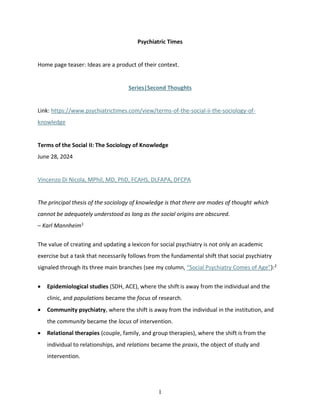
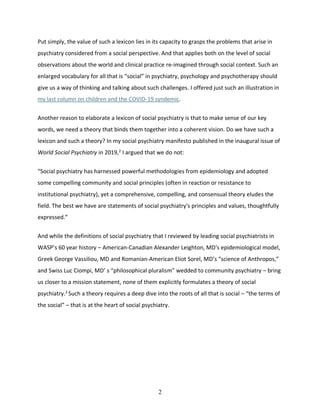
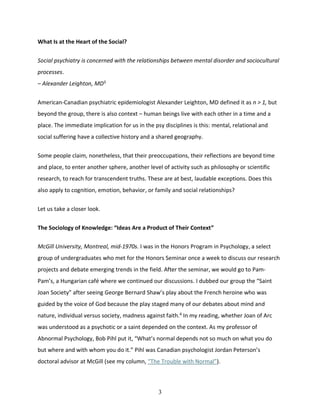
![4
One afternoon, I invited my friend Judy, a sociology student who had introduced me to the
work of Hungarian Jewish sociologist Karl Mannheim on the sociology of knowledge. As it
happens, Mannheim whose career brought him to the London School of Economics, founded by
George Bernard Shaw and the Fabian Society, was also involved in a discussion group in London
called “The Moot” that included Anglo-American poet T.S. Eliot on the role of religion and
culture in society.
The core of Mannheim’s theory on the sociology of knowledge concerns the relationship
between culture, including knowledge, and what he called “social reality.” The case studies of
ideology and utopia, which gave his most famous book its title, proposed that everyone’s
beliefs were a product of the context in which they were created:
The sociology of knowledge seeks to comprehend thought in the historical-social
situation out of which individually differentiated thought only very gradually emerges.1
Mannheim’s ideas were met with both curiosity and criticism by our group, so we staged a
debate between Steve Pinker and myself, with my friend Judy as an invited guest, at our honors
seminar. Judy and I presented an overview of Mannheim’s work with the message that “ideas
are a product of their context” and what it meant for psychology.
Our examples ranged from the psychology that emerged from the collectivist Soviet Union with
such thinkers as Lev Vygotsky on the social origin of mind and neuropsychologist Alexander
Luria who together founded cultural-historical psychology to the behavioral psychology of B.F.
Skinner and Freudian psychoanalysis of the more individualistic USA. And we brought this point
home with a study that was very topical in developmental psychology, Urie Bronfenbrenner’s
Two Worlds of Childhood5
– a book we had all read – that compared growing up in the US and
the USSR. Bronfenbrenner claimed that, “interpersonal relationships, even [at] the smallest
level of the parent-child relationship, did not exist in a social vacuum but were embedded in the
larger social structures of community, society, economics and politics.”
Sui Generis: “Ideas Have a Life of Their Own”](https://image.slidesharecdn.com/secondthoughts-termsofthesocialii-thesociologyofknowledge-june282024-240701050451-da7c3678/85/Terms-of-the-Social-II-The-Sociology-of-Knowledge-4-320.jpg)

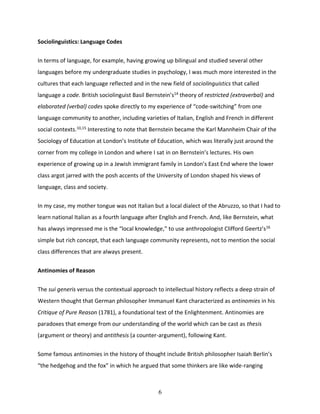
![7
divergent foxes (Shakespeare, Montaigne) while others are deeply-burrowing single-minded
hedgehogs (Dante, Dostoyevsky).
Closer to home, Carl Jung, MD called his version of psychoanalysis “depth psychology,”
burrowing deeply into the “collective unconscious,” while relational therapies range more
broadly across family and social relationships (see my column on family therapy
[https://www.psychiatrictimes.com/view/-the-web-of-meaning-family-therapy-is-social-
psychiatrys-therapeutic-branch]). In fact, we can generate almost endless examples of this
antinomy between individual and collective notions: “person-centered psychiatry” versus social
psychiatry or “single-case studies” versus group comparisons.
Other Domains – Philosophy, Literature, History
In highly personal memoirs and reflections that were so unique that they created a new form,
the essay, French philosopher Michel de Montaigne (1533-1592) scaled what he called “the
spiral staircase of the self.” If I had to choose the antinomic partner to Mannheim’s sociology of
knowledge, it would be Montagne’s essays. “I am myself the matter of my book,” he confessed
and turned himself into his own experimental subject.
Similar to the notion that “ideas have a life of their own,” the New Criticism concentrated
literary criticism on the text, arguing that a poem is “self-referential” with the “theory of
impersonality” and what Anglo-American poet T.S. Eliot called the “objective correlative.” The
“intentional fallacy” argued against the relevance of the writer’s intentions while the “affective
fallacy” set aside the reader's emotional reaction to a literary work as a valid means of
analyzing a text.
We can summarize this approach with the slogan: “the text itself” – not the writers’ biography,
nor their intentions, nor the cultural history of words, themes, and literary traditions, nor the
reader’s response. In other words, New Criticism takes the text out of social context. The
alternative is to attend to the history and meaning of words and the community in which they
arise. Sound familiar? That is what we try to do in relational therapy and social psychiatry.](https://image.slidesharecdn.com/secondthoughts-termsofthesocialii-thesociologyofknowledge-june282024-240701050451-da7c3678/85/Terms-of-the-Social-II-The-Sociology-of-Knowledge-7-320.jpg)
